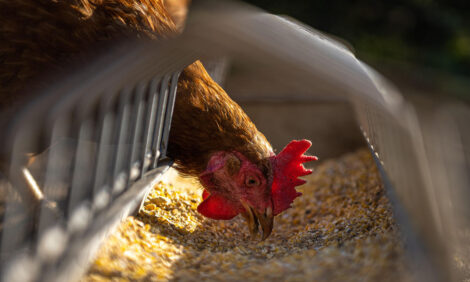



GB Emerging Threats Report – Avian Diseases – January-March (Q1) 2012
Myocarditis associated with reovirus infection in UK turkey populations, sinusitis in free-living Northern English red grouse and listeriosis in backyard poultry are among the highlights of this latest report from the AHVLA.Highlights
- Submission trends: Highest total number of Q1 avian diagnostic submissions
to AHVLA and SAC since 2008. During Q1-2012, the total number of avian
diagnostic submissions increased by 15 per cent, with non-carcass diagnostic
submissions up by 18 per cent and carcass submissions increased by 10 per cent compared
with Q1-2011, largely due to a rise in chicken flock submissions.
- New & Emerging diseases: Description of case of myocarditis associated with
reovirus infection in fattening turkeys. Seasonal investigations by AHVLA and
SAC of sinusitis due to respiratory cryptosporidiosis (Cryptosporidium baileyi
infection) in free-living red grouse in northern England.
- Unusual diagnoses: Listeriosis in association with Marek’s disease.
- Changes in disease patterns and risk factors: Confidence maintained in poultry meat sectors. BPC adopt changes to antimicrobial use in broiler supply chain. Volatility in layer sector - tightening of colony egg supplies in wake of EU ‘cage ban’ welfare legislation. Welcome increases in egg prices, but surge in chick placings, rising feed prices and free-range over-supply concerns.
New and Emerging Diseases
During Q1-2012 no new and emerging diseases were identified from analysis of available avian
scanning surveillance information for broilers, broiler breeders, layer breeders, layers, turkey breeders,
ducks, geese and backyard flocks.
However, one new and emerging disease investigation was
performed in commercial turkeys and another in game birds. There were no other new and emerging
disease investigations during the quarter.
Myocarditis associated with reovirus infection in fattening turkeys in the UK
Investigation of an episode of increased mortality affecting commercial, housed fattening turkey poults
from two weeks of age revealed histopathological lesions in the hearts of affected birds consistent with
those described in cases of ‘reovirus myocarditis’. This condition is recognised as a typically sporadic
disease affecting commercial meat-type turkeys in the USA (Shivaprasad et al., 2009; Franca et al.,
2010).
In the case investigated by AHVLA, in partnership with the private veterinary surgeon (PVS), batches of
9,500 poults were each placed simultaneously in two of five houses (H4, H5) on the same site. The birds
originated from different breeder flocks. In one of these houses (H4), early losses were experienced
(2.4 per cent by day 7) in common with a separate house (H2) where a proportion of the poults placed were
also from the same parent flock.
The onset of increasing mortality that was unresponsive to antimicrobial
treatment was then reported from days 11 to 14 in H4 and H5 resulting in cumulative losses of 4.5 to 5.5 per cent
by day 35 – at least double the expected average baseline cumulative mortality at this age.
Post-mortem
findings included low bodyweights, ascites and enlarged, pale, flaccid (rather than dilated or round)
hearts, with discolouration of the myocardium (Figures 3 to 5). Other gross lesions included subcutaneous
oedema, gizzard erosions and enteritis and caecal cores.

Histopathology examination of affected hearts revealed myocarditis lesions consistent with published
reports and a reovirus was also isolated. Subsequent collaboration with Dr. Shivaprasad has led to
confirmation that the observed histopathology lesions appear typical of turkey reovirus myocarditis seen
in the USA (Shivaprasad et al., 2009).
The appearance of an apparently identical condition in UK turkeys
is novel and laboratory investigations continue. Preliminary retrospective analyses by AHVLA have also
revealed one similar case with consistent pathology findings seen during June 2011. Reoviruses can
cause a range of conditions in turkeys, are considered ubiquitous and are not associated with public
health or international trade implications. The situation will continue to be monitored through AHVLA
scanning surveillance activities and PVS contact. AHVLA would therefore also be interested to hear from
colleagues who have experienced any similar cases.
Sinusitis in free-living red grouse in northern England
Since autumn 2010, SAC and AHVLA have investigated seasonal outbreaks (October to March) of an
upper respiratory tract (URT) disease characterised by swollen heads and ‘bulging eyes’ that has
affected small numbers of free-living red grouse (Lagopus lagopus scoticus) on moors and fells in
northern England.
In cases investigated by AHVLA, disease was usually noticed after a day’s shoot,
affecting up to one per cent of those shot.
Affected birds typically presented with swelling of one or both
infraorbital sinuses and eyelids with mucoid/catarrhal nasal discharge and similar exudates within the
nasal passages, infra-orbital sinuses and URT. In a few birds, the infra-orbital sinuses contained liquid
yellow to thick inspissated material. The birds were also often in relatively poor body condition.
There is
evidence that bacterial infection may be contributing to the disease in some individuals, but there
appears to be no involvement of Mycoplasma gallisepticum, a common cause of sinus swelling and
infection in pheasants and partridges; so-called ‘bulgy eye’ or infectious sinusitis.
Histopathological
examination has consistently revealed heavy cryptosporidial infection throughout the URT of all the birds
examined. PCR testing has identified this as Cryptosporidium baileyi, confirming a diagnosis of
respiratory cryptosporidiosis (SAC, 2011; Coldwell et al. in press).
These reports appear to be the first
time this disease has been diagnosed in free-living red grouse and, as such, appears to be a new and
emerging disease in GB. The condition in grouse, often referred to colloquially by gamekeepers as ‘bulgy
eye’ in other game birds, has also been reported in the game-keeping press but attributed to M.
gallisepticum infection.
It has also been suggested that the source of this ‘bulgy eye’ in grouse may be
other game birds (pheasants or partridges) on the periphery of the moors, or wild corvids. Conversely,
infected red grouse may pose a hazard to other species of wild or domestic bird. However, investigations
by AHVLA or SAC have so far not confirmed a reason for the apparent increase in respiratory
cryptosporidiosis in red grouse, nor a potential source of infection. It is possible the condition may have
been endemic in grouse populations, but at a previously low level. Spread may be mediated by the
natural movements of grouse between moors.
Whilst cryptosporidiosis is important in people and other
animals, the host range of Cryptosporidium baileyi is considered to be restricted to birds. Therefore,
there are no recognised public health implications (McDougald, 2008). AHVLA and SAC surveillance
activities will continue to monitor for the presence of the disease in free-living/wild and reared birds.
Ongoing New and Emerging Disease Investigations
Laboratory and/or field investigations continue into reported cases of ventriculitis in commercial freerange layer flocks in GB and a seasonal respiratory disease in adult pheasants (so-called ‘autumn cough syndrome’), as reported in the previous quarterly avian diseases Emerging Threats Report (October- December 2011): http://vla.defra.gov.uk/reports/docs/rep_survrep_qtlya0411.pdf. Further updates will be provided in due course.
Unusual Diagnoses
Listeriosis: Cases of listeriosis in backyard poultry, as well as other issues relating to trends in backyard
poultry ownership in GB and flock health, were summarised in the previous quarterly report.
On average, only one or two diagnoses
of listeriosis are recorded in poultry by AHVLA per year (VIDA, 2010), usually associated with other risk
factors for infection. Interestingly, Listeria monocytogenes was detected during January 2012 in a small
flock of 35 hens where Marek’s disease was thought to have been responsible for six deaths. Concurrent
coccidiosis and L. monocytogenes infection was found in one bird. However, both conditions were
considered to be secondary to the debility and immunosuppression associated with Marek’s disease.
During Q1-2012, and in common with other quarters, Marek’s disease (MD) was often involved in
backyard flock health problems with a multifactorial aetiology including coccidiosis, Brachyspira
intermedia, endoparasitism and red mite (Dermanyssus gallinae) infestation (AHVLA, 2012). MD can be
difficult to control in backyard flocks because vaccination, which is used in the commercial sector, is not
often a practical option in smaller size flocks. The situation will continue to be monitored through
scanning surveillance activities and PVS contact.
In each of these cases, no wider threats were recognised and no specific actions required other than for
producers and veterinarians to maintain vigilance for disease problems and investigate as appropriate.
Further ReadingFind out more information on the diseases mentioned in this report by clicking here. |
Further ReadingYou can view the full report by clicking here. |
May 2012








